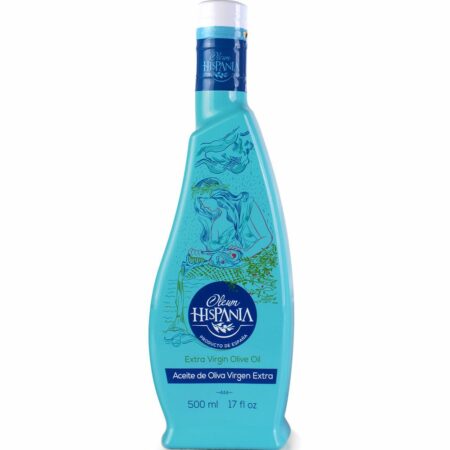Extra natives Olivenöl aus Spanien ist die Quintessenz der spanischen Sonne, des Bodens und der jahrhundertealten Oliventradition, die Spanien nicht nur zum größten Produzenten, sondern auch zum Experten für Olivenöl weltweit macht. Ausgewählte, hochwertigste Olivensorten wie Picual, Hojiblanca und Arbequina werden kalt gepresst, um ihren einzigartigen Geschmack, ihr Aroma und alle gesundheitlichen Eigenschaften zu bewahren. Jeder Tropfen unseres extra nativen Olivenöls ist die Essenz des reichen und vielfältigen spanischen Terroirs, von den grünen Hügeln Andalusiens bis zu den sonnigen Küsten Kataloniens, was eine Geschmacksvielfalt garantiert – von dezent süß über fruchtig bis hin zu kräftig und pikant.
Alle 8 Ergebnisse werden angezeigt
-
Natives Olivenöl Extra Oleum Hispania – Premium EVOO Fire 500ml
Ursprünglicher Preis war: 38,90 €33,90 €Aktueller Preis ist: 33,90 €. Weiterlesen -
Natives Olivenöl Extra Oleum Hispania – Premium EVOO Air 500ml
Ursprünglicher Preis war: 38,90 €33,90 €Aktueller Preis ist: 33,90 €. Weiterlesen -
Natives Olivenöl Extra Oleum Hispania – Premium EVOO Water 500ml
Ursprünglicher Preis war: 38,90 €33,90 €Aktueller Preis ist: 33,90 €. Weiterlesen -
Natives Olivenöl Extra – Bio – Premium EVOO Earth 500 ml
Ursprünglicher Preis war: 38,90 €33,90 €Aktueller Preis ist: 33,90 €. Weiterlesen -
Natives Olivenöl Extra Oleum Hispania – Premium EVOO El Gourmet de la Roja 500ml
Ursprünglicher Preis war: 38,90 €33,90 €Aktueller Preis ist: 33,90 €. Weiterlesen
Herkunft und Geschichte: Das Erbe des spanischen Olivenöls
Spanisches Olivenöl, weltweit bekannt für seinen einzigartigen Geschmack und seine unvergleichlichen gesundheitlichen Vorteile, hat einen festen Platz in der Geschichte und Kultur Spaniens. Schon in der Antike wurden die Gebiete des heutigen Spaniens für ihre idealen Bedingungen für den Olivenanbau geschätzt, wodurch diese Region schnell zu einem der Hauptproduzenten von Olivenöl wurde. Die Phönizier und später die Römer entwickelten den Olivenanbau auf der Iberischen Halbinsel, wobei sie das günstige Klima und die fruchtbaren Böden nutzten. Im Mittelalter, unter der Herrschaft der Mauren, wurden die Bewässerungstechniken und die Olivenanbaumethoden erheblich verbessert, was zur weiteren Entwicklung der Ölproduktion beitrug. Die Mauren führten neue Olivensorten ein, die bis heute überlebt haben und die Basis für die moderne spanische Olive bilden.
Im Laufe der Jahrhunderte wurde die Tradition der Olivenölproduktion untrennbar mit dem spanischen Land und der Kultur verbunden. Spanische Olivenölproduzenten, die ihr Wissen von Generation zu Generation weitergeben, haben ihre Methoden verfeinert, um das Beste aus den Oliven herauszuholen. Dieses Erbe ist nicht nur eine Frage der Anbau- und Produktionsmethoden, sondern auch eine tiefe Achtung vor dem Land und seinen Gaben. Olivenöl aus Spanien ist nicht nur ein Produkt; es ist die Geschichte von Menschen, die mit Liebe und Hingabe Oliven anbauen, und das Olivenöl zu echtem flüssigem Gold machen. Heute ist Spanien weltweit führend in der Olivenölproduktion und exportiert seine Produkte an Konsumenten weltweit, die ihren Gerichten einen Tropfen spanischer Sonne hinzufügen möchten.
Produktionsregionen: Geschmackskarte Spaniens
Die Olivenölproduktionsregionen in Spanien bilden eine Geschmacksmosaik, die den Reichtum und die Vielfalt der Landschaft dieses Landes widerspiegelt. Andalusien, die größte und bekannteste Produktionsregion, ist bekannt für Öl mit intensivem Geschmack und goldener Farbe, das Ergebnis des heißen, trockenen Klimas und des reichen, kalkhaltigen Bodens. In diesem Teil Spaniens, insbesondere in den Provinzen Jaén, Córdoba und Sevilla, befinden sich die meisten Olivenhaine, die einen erheblichen Teil der spanischen Ölproduktion liefern. Charakteristisch für dieses Öl sind Noten von grünen Blättern, Artischocken und Kräutern, die es ideal für Salate und als Zusatz zu frischem Brot machen.
Katalonien bietet andererseits ein Öl mit einem feineren Geschmack, mit spürbaren Mandelnoten, das Ergebnis des kühleren Klimas und der Vielfalt der Olivensorten wie Arbequina. Öl aus dieser Region wird für seine subtile Balance geschätzt und wird oft in feinen Gerichten verwendet, die eine subtile Ölnote erfordern. Im Norden, in der Region Aragon, wird Öl aus der Sorte Empeltre produziert, das mild und fruchtig ist, mit einem fast süßen Finish, ideal für Brot und Desserts. Galizien, obwohl es keine typische Olivenregion ist, experimentiert mit dem Olivenanbau in seinem feuchten, atlantischen Klima und bietet einzigartige Öle mit deutlich unterschiedlichen Geschmacksprofilen.
Es lohnt sich auch, Extremadura und Kastilien-La Mancha zu erwähnen, wo Öle mit einem stärkeren, entschiedeneren Geschmack produziert werden, die sich hervorragend mit traditionellen spanischen Gerichten kombinieren lassen. Jede dieser Regionen trägt zu der außergewöhnlichen Geschmackspalette des spanischen Olivenöls bei und schafft ein Produkt, das so vielfältig ist wie das Land selbst. Die Geschmackskarte Spaniens, geformt durch Olivenöl, ist nicht nur ein wertvoller Teil des kulinarischen Erbes, sondern auch ein Schlüssel zum Verständnis der regionalen Unterschiede und des Reichtums der spanischen Kultur.
Produktionsprozess: Vom Baum zur Flasche
Der Produktionsprozess von Olivenöl, vom Baum zur Flasche, ist sorgfältig entwickelt, um die einzigartigen Eigenschaften und den Geschmack dieses wertvollen Fluids zu bewahren. Angefangen beim Olivenanbau, spielt alles eine Rolle – von der Auswahl des richtigen Standorts über die Sorge um die Gesundheit und Reife der Oliven bis zum Zeitpunkt der Ernte. In Spanien, wo Oliven Teil der Landschaft und Kultur sind, ist jeder Produktionsschritt von Tradition durchdrungen, obwohl er heutzutage durch moderne Technologie unterstützt wird.
Die Olivenernte ist der erste Schritt im Produktionsprozess von Olivenöl. Oliven werden entweder von Hand oder mit mechanischen Rüttlern geerntet, die die Früchte sanft auf unter den Bäumen ausgebreitete Netze fallen lassen. Es ist wichtig, dass die Oliven zum richtigen Reifezeitpunkt geerntet werden, da dies den Geschmack, das Aroma und die gesundheitlichen Eigenschaften des Öls beeinflusst. Anschließend werden die Oliven sortiert und gewaschen, um Verunreinigungen zu entfernen.
Der Ölpressungsprozess beginnt mit dem Mahlen der Oliven – ganz, mit Kernen, Schale und Fruchtfleisch – zu einer Paste. Traditionell wurden Steinkugelmühlen verwendet, aber heute werden häufiger Metallmühlen oder Schneckenpressen verwendet, die eine einheitliche Konsistenz der Paste gewährleisten. Der nächste Schritt, die Malaxation, involves the slow mixing of the paste, which allows oil droplets to coalesce. This phase is crucial for extracting as much oil as possible and shaping its character.
The extraction of oil from the paste occurs through physical processes such as pressing or centrifugation. Pressing involves squeezing the paste between large, flat plates, which separates the oil from the rest of the olive components. In modern methods, centrifugation is more commonly used, which effectively separates the oil from the water and solid pulp particles. The oil obtained in this way is then filtered to remove remaining particles, improving its clarity and extending its shelf life.
The final stage, storage and bottling, is equally important for maintaining the quality of the oil. The oil is stored in steel tanks or ceramic vessels, in a controlled temperature environment, away from light and oxygen, which can negatively affect its taste and properties. Bottling takes place under hygienic conditions, using dark glass bottles or other packaging that protects against light.
Types and Classifications: Understanding the Variety
Understanding the variety of types and classifications of olive oil is crucial for appreciating its richness and complexity. Olive oil, though seemingly a simple product, encompasses a wide range of flavors, aromas, and properties that depend on many factors, such as the variety of olive, growing region, climatic conditions, harvesting method, and production process. In Spain, one of the leading olive oil producers in the world, this diversity is particularly evident and valued, reflected in classifications that help consumers navigate the world of olive oil.
The basic division of olive oil is its quality categories: extra virgin olive oil, virgin olive oil, and refined olive oil. Extra virgin olive oil is considered the highest quality, produced exclusively by mechanical methods, without the use of chemical processes, ensuring its excellent taste and aroma and low acidity not exceeding 0.8%. Virgin oil, although also mechanically produced, has slightly higher acidity and may exhibit minor flavor defects. Refined oil is produced by refining technical oils, which improves their sensory imperfections but also removes some natural aromas and health properties.
The next level of diversity relates to the olive varieties from which the oil is produced. Spain grows over 200 varieties of olives, each contributing a unique set of characteristics to the oil. Varieties such as Picual, Hojiblanca, Arbequina, and Cornicabra are popular and valued for their distinctive flavor profiles – from intensely bitter and spicy to delicate and fruity.
The production region is another factor influencing the diversity of olive oil. Spain, with its varied landscape and climate, offers oils with varied flavor profiles that reflect the character of each region. Andalusia, Catalonia, Valencia, and La Rioja, each of these regions produces oils that can vary greatly from each other, offering consumers a wide range of sensory experiences.
Understanding the classifications and types of olive oil not only allows for a better appreciation of it as a culinary product but also facilitates making informed purchasing decisions. When choosing olive oil, it’s worth paying attention to its quality category, olive variety, and regional origin to fully enjoy its unique taste and health properties.
Health Benefits: More Than Just Taste
Olive oil is not only valued for its unique taste and versatility in the kitchen but also for the numerous health benefits it offers. Rich in monounsaturated fatty acids, primarily oleic acid, it helps lower the level of bad cholesterol (LDL) while raising the level of good cholesterol (HDL), supporting heart and circulatory health. Additionally, olive oil contains antioxidants, such as vitamin E, polyphenols, and phytosterols, which have anti-inflammatory, antiviral, and anticancer effects, helping protect the body from various diseases, including heart disease and some types of cancer.
The anti-inflammatory action of olive oil is particularly important, considering that chronic inflammation is recognized as one of the main causes of many chronic diseases, including type 2 diabetes, heart diseases, obesity, and Alzheimer’s disease. Polyphenols in olive oil, such as oleuropein and hydroxytyrosol, can reduce inflammation in the body, which translates to better overall health and reduced risk of the aforementioned conditions.
Another health aspect is the impact of olive oil on weight control. Despite its high calorie content, regularly incorporating olive oil into the diet can help maintain a healthy weight and even contribute to fat reduction. Studies suggest that monounsaturated fatty acids support energy balance and can increase the feeling of fullness, which helps control appetite.
Culinary Uses: Inspiration for Creative Gourmets
Olive oil, a treasure of Mediterranean cuisine, has inspired chefs and gourmets around the world for centuries. Its unique flavor and health properties make it an indispensable element of creative cooking. Not only does it enhance the taste of dishes, but it also adds depth and aroma. Extra virgin olive oil, with its intense flavors and aromas, is ideal for raw use, as a finishing touch to dishes, dressing for salads, or base for marinades and sauces. Its rich flavor bouquet pairs beautifully with vegetables, fish, and seafood, creating dishes full of taste and freshness.
Culinary inspirations using olive oil are endless. Olive oil is perfect as a base for making homemade pesto – both classic basil and other variants with arugula, spinach, or nuts. Additionally, using olive oil in salads goes beyond dressing. It can be combined with citrus, creating refreshing sauces perfect for light, summer salads. Olive oil is also used for preserving – vegetables such as tomatoes, peppers, or artichokes in oil are delicacies that can serve as an addition to many dishes or as a standalone snack.
How to Choose and Store Spanish Olive Oil
Choosing and storing Spanish olive oil are key aspects to enjoying its best flavor and benefiting from its health properties. Spain, being one of the leading olive oil producers in the world, offers a wide range of oils, differing in variety, region of origin, and flavor profile. To make an informed choice, it’s important to consider a few crucial issues.
How to Choose Spanish Olive Oil
- Type of oil: Look for extra virgin (highest quality) or virgin oil, which are mechanically produced without the use of chemicals, ensuring the preservation of natural taste, aroma, and health properties.
- Quality markings: Spanish oils often have quality markings, such as DOP (Denominación de Origen Protegida) or IGP (Indicación Geográfica Protegida), indicating geographic origin and compliance with specific quality standards.
- Harvest date: Olive oil is a fresh product, so look for information on the harvest date. Fresher oil offers a better flavor profile and more antioxidants.
- Packaging: Olive oil is best preserved in dark glass bottles or other packaging that protects it from light and oxygen.
How to Store Spanish Olive Oil
- Avoid light and heat: Store olive oil in a dark and cool place, away from heat sources such as windows or stoves. Light and heat can accelerate the oxidation process, negatively affecting the taste and properties of the oil.
- Keep the packaging sealed: After opening the bottle, make sure it is always well sealed. Contact with oxygen accelerates the degradation of the oil.
- Consider storing in a dark cabinet or pantry: Ideal conditions are a temperature of 14 to 22 degrees Celsius. Avoid storing olive oil in the refrigerator, as low temperatures can affect its consistency and taste.
- Use in a timely manner: Although olive oil is relatively durable, it is best used within a few months of opening to enjoy its best flavor and aroma.
By keeping these tips in mind, you can maximize the benefits of Spanish olive oil, both in terms of taste and health. Well-chosen and properly stored olive oil will be a valuable addition to your kitchen.













